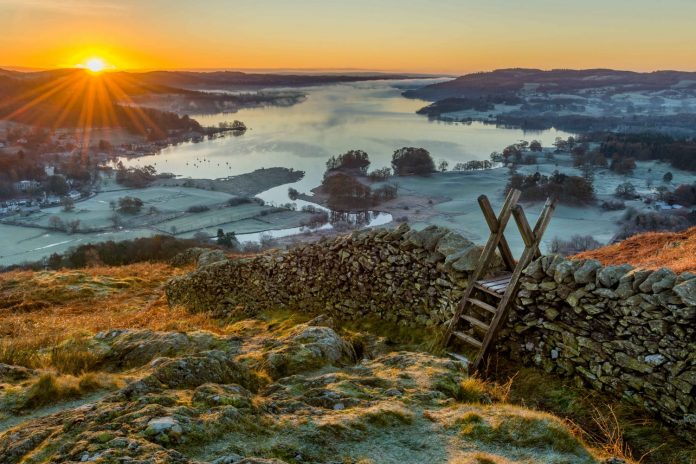Travellers planning an itinerary for their holiday in the UK need look no further than Lonely Planet’s Ultimate United Kingdom Travelist. The new book ranks the top 500 unmissable experiences and hidden gems across Great Britain, Northern Ireland and the Channel Islands – and we can reveal the top 10 here:

1. See the greatest shows on earth at the Edinburgh Festival Fringe
Edinburgh – Walking down the Royal Mile, set against the brooding backdrop of Edinburgh Castle and a congregation of medieval rooftops, it isn’t the knife-throwing unicyclist that first stops you in your tracks. Neither is it the a cappella choir rehearsing in the shadows of St Giles’ Cathedral, nor the gussied-up collective of artists including bare-chested Korean drummers, a karaoke version of Macbeth, a soap-bubble circus and a group of preening Thai ladyboys. Even the camera-ready crowds lining up to take photos aren’t surprised by them. Instead, it is the zombified drag queen, pulling balloons from between her buttocks, that brings the street to a standstill.
At such times, there’s no shame in being baffled by the world’s largest arts festival. Quite simply, the Fringe floods the city with art and nowhere beats it for spectacle or scale. Strangeness, too. Come August in Edinburgh, everything seems brighter, barmier and more colourful. To negotiate such a minefield of creative freedom, it’s best to tackle the Fringe over several days, dipping in and out of shows aided by word-of-mouth reviews and tips picked up in the pub. There is theatre, comedy, dance, circus, cabaret, opera, music and spoken word, and whatever the time of day, an acrobat, trapeze artist, contortionist or tried-and-tested bagpiping busker will be pleased to entertain you. Plan ahead too much and you’ll miss the freedom of spontaneity, but come ill-prepared and you may find the hot tickets already sold out.
2. Take a world tour of treasures at the British Museum
London – Some museums are travel destinations in themselves. The British Museum – the first-ever public national museum – is the envy of the world, with good reason in some cases, considering the many treasures obtained under questionable circumstances in colonial times. Yet this miraculous museum started life as a humble cabinet of curiosities, assembled by 18th-century physician and hot-chocolate inventor, Sir Hans Sloane. As a condition of bequeathing his treasures to the nation, he ordered that they be open for free to ‘all studious and curious persons’, a tradition that persists to this day.
Early on, the collection was dominated by natural history, books and drawings, but the kleptomaniac zeal of the colonial period saw it stuffed with gifted, borrowed and purloined treasures from across the globe, from mummified Pharaohs to the Parthenon Marbles, alongside the greatest treasures unearthed in the British Isles. Putting disputes over ownership to one side, visitors today are transported on a whirlwind world tour of human creativity. If human beings have made it, somewhere in the world, there’s a chance you’ll find an example among the display cases. One side effect of this globetrotting collection is that the museum speaks to the culture of almost everyone who walks in the door.
There’s far too much to take in on one trip; if you only have a day, make a beeline for the Egyptian treasures, the Parthenon Marbles and quirky British antiquities such as the Sutton Hoo helmet and the Lewis chessmen.

3. Step ogre-sized strides over hexagonal stones at the Giant’s Causeway
Northern Ireland – The descent down from the cliffs to the strange rocks of the Giant’s Causeway feels at once timeless – the scene has remained the same for countless centuries – and unrepeatable: the moody skies, the light and the temperament of the sea are constantly changing. Equally exhilarating when cloaked in fairytale mist as when bathed in bright sunshine or whipped by howling winds, uneven stacks of hexagonal basalt columns stand in neat clusters along the water’s edge, emerging from the shore like tightly packed tower blocks in a city skyline. The low rumble of the ocean builds into a roar as white-tipped water creeps up and crashes over the rocks, lapping the stones as it retreats. Northern Ireland’s only Unesco World Heritage site is shrouded in a sense of magic, myth and natural wonder.
Legend has it that Irish giant Finn McCool built a causeway across the sea as a way to reach his rivals in Scotland. One day, the Scottish giant Benandonner followed Finn back to Ireland, but he was tricked by Finn and retreated home to Scotland, ripping up the causeway behind him. Giants aside, scientists put the formation of the rocks down to volcanic activity some 60 million years ago. As the lava flow cooled and hardened it contracted, creating a honeycomb pattern.
After clambering over the pillars on the shore, check out the Organ, a rock formation resembling organ pipes, and the Chimney Stacks headland, which looks like industrial chimneys on the edge of the ocean. A clifftop path leads to the Amphitheatre viewpoint and down the Shepherd’s Steps to the shore; there’s also a minibus that runs to the rocks from the visitor centre, where you can learn more about the causeway’s history, geology and legends.

4. Experience how the Romans bathed in Bath
Southwest England – If there’s one thing the Romans liked better than anything – except perhaps straight roads, good sanitation and gladiatorial gore – it was a nice hot bath. And 2000 years ago, when Britain was under Roman rule, they built a sumptuous bath complex at a site known as Aquae Sulis (present-day Bath), taking advantage of the area’s geothermal hot springs, which warm the underground water to 46°C (115°F).
Though now swallowed up by the modern city of Bath, most of the structure is still standing – including bathing pools, changing rooms, the original hypocaust heating system and the central Great Bath, lined with lead and filled with 5.2ft of steaming, geothermally heated water. In fact, it’s one of the best-preserved Roman bathhouses in the world, and gives a fascinating glimpse into their everyday lives (and fastidious ablution habits). The only disappointment is that it’s no longer permitted for people to take a dip here – but you can get pretty close to a bona fide Roman bathing experience at the Thermae Bath Spa nearby, complete with its postcard-worthy panoramic rooftop pool.

5. Retrace the Romans’ footsteps along Hadrian’s Wall
Northeast England – Hot on the heels of Bath’s namesake thermal baths is another mighty Roman legacy – an enormous defensive wall stretching 73 miles across Britain. This phenomenal feat of engineering was built under Roman emperor Hadrian between AD 122 and 128 to keep out Scottish Picts. Rising to a height of up to 15ft, with a width of almost 10ft, it took 15,000 men six years to construct it from local whinstone (dolerite). Only 10% survives today, but what does makes an unforgettable impression.
Along the wall were 80 mile-castle forts, with observation turrets between them. Larger forts were built in the south, with 16 more lying astride the wall, which you can visit today. Staggering remains that serve as reminders of the Romans’ advancements include the hospital at Housesteads Fort, ventilated granaries and barracks, as well as flushable communal latrines.
Exploring sections of the wall is easy thanks to good rail and road access (including buses), but if you’re up for an adventure, you can complete the national Hadrian’s Wall Path walking trail along its length in about a week.

6. Make a British weekend of it with a Sunday pub roast
Fewer and fewer people in Britain start Sunday with a trip to church, but the roast lunch is still a lock. For visitors, it’s a must-do experience. It doesn’t matter whether you’re in a centuries-old, windowless pub in London or at a large country inn with tables sprawling over a lawn, you’ll be among friends and families laughing, drinking beer and tucking into plates of hot sliced roast beef or pork, Yorkshire pudding, roasted potatoes and assorted veggies, all slathered in gravy. Warming, filling and indulgent, it’s comfort food par excellence. But more than that, it’s a reassuring experience, a weekly ritual where the nation stops time, staves off the start of the working week and lives in the moment. Grab a plate and take your fill.

7. Discover a powerhouse of modern art at Tate Modern
London – London’s art galleries were once stuffy, nostalgic, Portland-stone institutions, heavy with history. But when Tate Modern opened in 2000, in the hollowed-out shell of the decommissioned Bankside Power Station, modern art finally got an address to be proud of. Now housing the Tate’s art collection from 1900 to the present day, the gallery has exploded beyond its original footprint, with new galleries inside the power station and the Blavatnik Building rising behind like a twisted ziggurat. Inside, you might see anything from permanently displayed Rothkos, Dalís and Picassos to visiting masterpieces by Monet, Matisse and Warhol, and eccentric installations from the likes of Ai Weiwei, Rachel Whiteread and Anish Kapoor. Before you leave, head to the top-floor viewing deck for stunning city views

8. Marvel at the mighty megaliths of Stonehenge
Southwest England – Just what were ancient Britons playing at when they hauled these giant stones into place all those millennia ago? Stonehenge, on Salisbury Plain near Amesbury, is a monumental, undeniably mind-boggling achievement. Built in stages between around 4500 BC and 1500 BC, Stonehenge’s massive stones (some weighing 25 tonnes) were probably erected using a system of sledges, rollers, pivots and pulleys; some were transported here from the Preseli Hills in Wales, 140 miles away.
But despite decades of academic study, no one really has the foggiest why Stonehenge is there. Oriented around the solstices, it forms part of a larger sacred site, including barrows, burial mounds, earthworks and a ceremonial pathway, the Avenue. But what did this site mean to its builders? Is it a temple? A sacrificial centre? A place of healing? A memorial to the ancestors? An astronomical timepiece? The truth is, nobody knows. And standing in the shadow of the stones, feeling their power and presence, it’s impossible not to let your imagination run wild.

9. Find poetry on the shores of Lake Windermere
Cumbria – England’s largest natural lake – 10.5 miles from Ambleside to Newby Bridge – is at the heart of the Lake District and its most popular destination. People come in search of the scenic splendour and bucolic experiences that inspired Wordsworth, Coleridge and the English Romantics.
You can visit Wordsworth’s house at Rydal Mount, or ride across the lake on a 19th-century steamer (sketchbook and pencil optional) just as the Victorians did. For more modern pursuits, the adventure centre at Brockhole, on the eastern side, has a zip wire running between 250-year-old oak trees.
Most activity is focused on the twin towns of Windermere (on a hill overlooking the lake) and busy Bowness-on-Windermere, which is home to the boat docks, a cluster of shops and the World of Beatrix Potter, which brings to life the most famous creations of the writer who dedicated her life to the preservation of the Lake District.
Far more evocative is Wray Castle, the mock-Gothic structure used by Potter’s family as a holiday home. It’s now empty but the lake views from the battlements are impressive; get there by boat from Bowness.

10. Explore Pembrokeshire Coast National Park
South Wales – There’s more to Wales than sheep, drizzly valleys and place names that are impossible to pronounce for outsiders. If you haven’t been to the Pembrokeshire Coast National Park in the country’s ‘wild west’, you are missing a trick. Wholly deserving of its number 10 Travelist slot, this ravishing stretch of cliff-flanked coves, thrashing seas, wildflower-freckled moors and hedge-lined tracks leading to one-pub villages still feels like a great escape. Life around here moves in the slow lane.
You’ve come for the beaches? Wise choice, you’re in for a treat. Tenby in the south offers a classic dose of ice-cream-licking, bucket-and-spade fun. But the further west you head, the wilder it gets, with the likes of crescent-shaped Barafundle Bay, reached on foot through the dunes, surf-hammered Freshwater, and tucked-away Marloes with its high sea cliffs, shipwreck and boats heading over to puffin island, Skomer. A terrific base for beach-hopping and coastal-hiking is St Davids. Britain’s smallest city is charm personified, with a whopping medieval cathedral, lanes staggering down to the sea, and a couple of highly stylish, architect-designed hotels, including art-slung former windmill Twr Y Felin and one-time Victorian convent Penrhiw.
Break up drives by striking out on the 186-mile Pembrokeshire Coast Path, which dips and rises over kissing gates and windy clifftops to smuggler’s coves, wooded hollows where brooks burble, and Neolithic burial chambers. To up the adventure, go coasteering with the pros at eco-lodge Preseli Venture. Or turn your focus inland to the lonely Preseli Hills, a windswept range of rocky outcrops, low-lying peaks capped with prehistoric standing stones, and moorland flecked with gorse and heather.
Want to start exploring and experiencing the best the UK has to offer? Buy the Ultimate United Kingdom Travelist.




